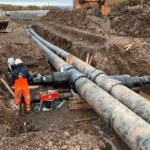Scotland has made significant progress in developing its infrastructure in the past decade, despite the challenges posed by the Covid-19 pandemic, Brexit and climate change. However, these achievements are often overlooked or downplayed by the mainstream media and the UK government. This article highlights some of the key infrastructure successes that Scotland can be proud of, as well as the areas that need further improvement.
Renewable energy
Scotland is a world leader in renewable energy, with a target of reaching 100% of its electricity demand from renewable sources by 2020. According to the latest figures, Scotland generated 97.4% of its electricity consumption from renewables in 2020, up from 90.1% in 2019. This is a remarkable feat, considering that Scotland has a population of 5.4 million and a land area of 78,772 km2, compared to Germany’s 83.2 million and 357,386 km2, which generated 46% of its electricity from renewables in 2020.
Some of the notable renewable energy projects in Scotland include:
- The Beatrice Offshore Wind Farm, which is the fourth largest offshore wind farm in the world, with a capacity of 588 MW and enough power for 450,000 homes.
- The MeyGen Tidal Stream Project, which is the largest tidal stream project in the world, with a capacity of 398 MW and enough power for 175,000 homes.
- The Whitelee Wind Farm, which is the largest onshore wind farm in the UK, with a capacity of 539 MW and enough power for 300,000 homes.
Scotland is also investing in innovative technologies such as floating wind turbines, hydrogen production and storage, and carbon capture and storage, to further enhance its renewable energy potential and reduce its greenhouse gas emissions.
Transport
Scotland has also made significant improvements in its transport infrastructure, with a focus on enhancing connectivity, accessibility, safety and sustainability. Some of the major transport projects that have been completed or are underway in Scotland include:

- The Queensferry Crossing, which is the longest three-tower cable-stayed bridge in the world, spanning 2.7 km across the Firth of Forth. It opened in 2017 and carries the M90 motorway, relieving congestion and improving reliability on the Forth Road Bridge.
- The Aberdeen Western Peripheral Route, which is a 58 km bypass road that opened in 2019 and connects the north, south and west of Aberdeen. It reduces journey times, improves safety and supports economic growth in the region.
- The Borders Railway, which is a 48 km railway line that opened in 2015 and connects Edinburgh with the Scottish Borders. It is the longest new domestic railway to be constructed in Britain for over 100 years and has boosted tourism, employment and social inclusion in the area.
Scotland is also investing in electrifying its rail network, expanding its bus and tram services, promoting active travel modes such as cycling and walking, and developing low-carbon transport options such as electric and hydrogen vehicles.
Digital connectivity
Scotland has also made significant progress in improving its digital connectivity, especially in rural and remote areas. According to the latest figures, 94% of premises in Scotland have access to superfast broadband (speeds of 30 Mbps or more), up from 87% in 2019. This compares favourably with the UK average of 96%. Furthermore, 4G mobile coverage in Scotland has increased from 58% in 2017 to 81% in 2020.
Some of the key digital connectivity projects in Scotland include:
- The Reaching 100% (R100) programme, which aims to deliver superfast broadband to every home and business in Scotland by the end of 2023. It is the most ambitious broadband programme in the UK and will benefit over 180,000 premises across the country.
- The Scottish 4G Infill programme, which aims to improve mobile coverage in rural areas by building new masts and upgrading existing ones. It is funded by the Scottish Government and the European Regional Development Fund and will benefit over 60 communities across Scotland.
- The Digital Scotland Superfast Broadband programme, which has delivered fibre broadband to over 950,000 premises across Scotland since 2014, with a total investment of over £400 million from the public and private sectors.
Scotland is also investing in emerging technologies such as 5G, satellite broadband and smart cities, to further enhance its digital connectivity and competitiveness.
Challenges and opportunities
Despite these impressive achievements, Scotland still faces many challenges and opportunities in its infrastructure development. Some of the key issues that need to be addressed include:
- The impact of the Covid-19 pandemic, which has disrupted many infrastructure projects, changed travel patterns and increased demand for digital services. Scotland needs to adapt its infrastructure planning and delivery to the new realities and priorities of the post-pandemic world.
- The impact of Brexit, which has created uncertainty and risks for Scotland’s infrastructure funding, regulation and collaboration. Scotland needs to secure its fair share of the UK’s infrastructure spending, maintain high standards and safeguards, and foster partnerships with the EU and other countries.
- The impact of climate change, which poses serious threats and challenges for Scotland’s infrastructure resilience, adaptation and mitigation. Scotland needs to accelerate its transition to a net-zero economy, enhance its natural capital and biodiversity, and reduce its vulnerability to extreme weather events and natural disasters.
Scotland has a vision of becoming a world-class infrastructure nation by 2030, with a focus on delivering inclusive, sustainable and resilient infrastructure that meets the needs of its people, economy and environment. To achieve this vision, Scotland needs to continue to invest in its infrastructure, innovate its solutions, and collaborate with its stakeholders. Scotland has a lot to be proud of, but also a lot to look forward to, in its infrastructure journey.


















